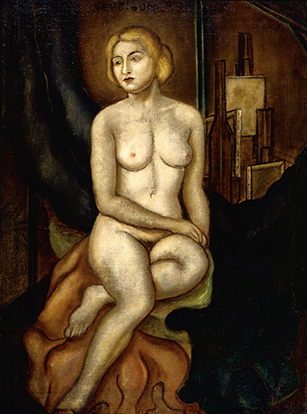Louise Nevelson
A new exhibition at the Farnsworth Art Museum reveals the depth of Nevelson’s work through pieces selected from the museum’s substantial collection
The intimate top-floor gallery of the Farnsworth Art Museum currently houses Louise Nevelson: Dawn to Dusk, an exhibition guest curated by Suzette McAvoy and drawn from the Farnsworth’s extensive Nevelson holdings, most of which were gifted to the museum by the artist or her family.
Louise Nevelson (1899–1988) was renowned for her monumental painted wood assemblages, and for being a pioneer of immersive sculptural environments known as installations. Among her many large-scale achievements was her contribution to the U.S. pavilion at the 31st Venice Biennale in 1962, and her silkscreened costumes and set design for the Opera Theater of St. Louis’s production of Orfeo ed Euridice, which she completed in her 80s. Nevelson was also a serious painter in her early career, at one point leaving New York City (and her marriage) to study with Hans Hofmann at his groundbreaking modern art school in Munich. McAvoy believes this decision was a turning point in Nevelson’s career, and that the mark of Hofmann’s teaching—his “push and pull” interplay between two- and three-dimensional pictorial space—was indelible.
Throughout her life, Nevelson was a fearless disrupter of norms and processes, sometimes dismantling a signature work to reassemble and repurpose its parts into something new, as in the assemblage/installation The Endless Column (1969–1985). Her spirit of experimentation and love of material possibilities also produced soft ground etchings drawn with fragments of lace, Cubist-inspired terra cotta figures, dimensional collages, and wooden jewelry constructions embellished with gold. It extended to her own appearance, in the ways she enhanced her deep-set eyes to sculptural effect with eyeliner and false lashes and dressed in elaborate, multi-textured clothing. “An artist who is crystallized in a style is no artist,” Nevelson declared in a 1960 press release.
Communing with Nevelson through works that span her lifetime, Dawn to Dusk is an opportunity to take in the depth and breadth of her production, but especially to experience her paintings and other lesser known early works and to consider Nevelson’s artistic journey. As a child who immigrated with her family to the Maine coast from present-day Ukraine in 1905, Nevelson’s earliest sense of herself as an artist occurred when she was recognized and encouraged by her teachers in Rockland, at a time when the commercial port town was a far cry from the art center it is today. “An outsider who spoke Yiddish at home, she needed to leave Maine to become Louise Nevelson,” McAvoy observes. Nevelson’s move to New York City was central to her art education and finding her way as an artist; her later returns to Rockland were “triumphal,” with multiple retrospective exhibitions at the Farnsworth in the late 1970s and 1980s.
The exhibition includes a tall, white wood assemblage titled Dawn Column I. The piece was originally made as one of ten “witnesses” to the marriage ceremony that was the subject of Nevelson’s celebrated 1959 installation Dawn’s Wedding Feast at the Museum of Modern Art in New York. Here, removed from the context of the original installation, Dawn Column I is a fragment of something that probably won’t ever be whole again, but it’s also still a witness, an onlooker, a sentinel, a guardian, and perhaps a keeper of secrets.
“I join the shattered world, creating a new harmony,” Louise Nevelson said, and continues to say, with infinite hope.





